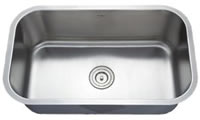There are few areas in the home that provide you with as many options as the bathroom basin or sink. Almost every material is available in bathroom basins, from basic porcelain to glass, copper, brass, ceramic and stainless steel with three mounting styles. You can purchase basins that drop into cutouts in the countertop, mount below the countertop and those that sit on top of the countertop.
As with kitchen sinks, it is important that you purchase the basin before you undertake designing the mold so that you will be able to incorporate the basin’s mounting style into the mold.
You can of course, if you feel you are comfortable in making molds, mold the basin as an integral part of the bathroom countertop.
Faucets and accessories
Along with choosing and purchasing your sink or basin before you construct the concrete countertop it is wise to choose and purchase your faucet and any accessories that will mount through the countertop. Faucets can have a single hole or multiple holes, other accessories such as soap dispensers require a specific hole size, usually 3/4 inch, but not always. By having the faucet and any accessories before you cast the concrete countertop you will be sure to create the holes in the positions and the sizes that each item requires.
Note: Many built-in dishwashers require an air-gap that mounts through the countertop. Don’t forget to include a hole for the air-gap if the dishwasher is mounted below the countertop and an air-gap is required.
Countertop inlays
Before we discuss countertop inlays it is very important to point out that it is very easy to get carried away with complex countertop designs and inlays, which require complex molds. If this is your first concrete countertop, then we suggest you stay with the basics until you have mastered the crafts of mold making, mixing concrete, curing, grinding and polishing. Every additional feature that you add to your concrete countertop makes it much more complex.
That being said there are a few items that you may wish to consider adding to the concrete countertop.
- Adding a sheet of stainless steel, within the top of the concrete countertop, next to a range makes a perfect landing spot for hot pots and roasting pans exiting the oven.
- Concrete plays havoc with the sharp edges of knives so you may wish to consider adding a butcher block cutting board inset into the concrete countertop.
- If you do a lot of baking, adding a marble or granite slab inlaid into the countertop is an excellent addition as concrete will stain from oily pastry dough.
The mold
There are two key elements to building your concrete countertop mold that you cannot forget, even for a moment:
- Any flaws or errors that are in the mold will appear cast in the concrete countertop. In other words the care and craftsmanship that you put into building the mold will determine the aesthetic appearance of the concrete countertop.
- The mold is the reverse to what you want to be cast. The bottom of the mold is the top of the countertop. The outside edge is in an opposite direction to where it will appear once the concrete countertop is removed from the mold.

Figure 3 - Undermount stainless steel sink
We will use a very basic concrete countertop design that has the following features:
- The length will be 84 inches and the width will be 25 1/2 inches (we are using a 1 1/2 inch overhang.
- The thickness of the concrete countertop will be 2 1/2 inches.
- It will have a cut-out for an undermount stainless steel sink that is 30 inch long by 18 inch wide, as shown in Figure 3.
- It will have a one-hole faucet with no additional countertop accessories.
Continued - Starting your concrete countertop build
How to Make Concrete Countertops - Index
